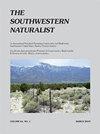ALOPECIA IN A POPULATION OF RAFINESQUE'S BIG-EARED BATS (CORYNORHINUS RAFINESQUII)
IF 0.2
4区 环境科学与生态学
Q4 Agricultural and Biological Sciences
引用次数: 1
Abstract
ABSTRACT We documented extreme alopecia in a maternal colony of Rafinesque's big-eared bats (Corynorhinus rafinesquii) roosting beneath a concrete bridge in west-central Mississippi in the spring of 2000. Approximately half of the colony lacked hair dorsally and ventrally in the chest, shoulder, and neck regions. We again observed partially hairless bats during 2004 and 2011 surveys. Dermatophyte cultures on skin and hair samples were positive on specimens examined in 2004, but fungi identified were nonpathogenic. Environmental stress is implicated as a potential factor contributing to alopecia in the population. RESUMEN En la primavera del año 2000, se documentó alopecia extrema en una colonia maternal del Murciélago orejón de Rafinesque (Corynorhinus rafinesquii) perchada bajo un puente de concreto en el área oeste-central de Mississippi. Aproximadamente la mitad de la colonia carecía cabello en las áreas dorsales y ventrales del pecho, cuello y de los hombros. Murciélagos parcialmente calvos fueron observados también durante los monitoreos de 2004 y 2011. Culturas de dermatofitos dieron positivas en muestras de la piel y del pelo tomadas en el muestreo del 2004, pero los hongos identificados no fueron patógenos. Estrés ambiental es considerado como un factor potencial que ha causado alopecia en la población.拉菲大型蝙蝠群体的脱发
2000年春天,我们记录了栖息在美国密西西比州中西部一座混凝土桥下的拉芬斯克大耳蝙蝠(Corynorhinus rafinesquii)母系群体的极度脱发现象。大约一半的蜂群在胸部、肩部和颈部背部和腹部没有毛发。在2004年和2011年的调查中,我们再次观察到部分无毛蝙蝠。2004年检测的皮肤和头发样本上的皮肤真菌培养呈阳性,但鉴定出的真菌是非致病性的。环境压力被认为是导致人群脱发的潜在因素。RESUMEN En la primavera del año 2000, se documentó斑秃极端En En una colonia母系del murciacylago orejón de Rafinesque(长鼻毛猴rafinesquii) perchada bajo un puente de concreto En el área oest -central de Mississippi。接近殖民时期carecía cabello en las áreas dorsales y ventrales del pecho, cuello y de los hombros.。在2004年和2011年的监测期间,特别观察了murciemacos和murciemacos。在2004年的一项研究中,研究人员发现了皮肤细菌的阳性反应,并发现了细菌的阳性反应。环境因素是一个重要的潜在因素,可能会导致脱发。
本文章由计算机程序翻译,如有差异,请以英文原文为准。
求助全文
约1分钟内获得全文
求助全文
来源期刊

Southwestern Naturalist
环境科学-生态学
CiteScore
0.50
自引率
50.00%
发文量
47
审稿时长
18-36 weeks
期刊介绍:
The Southwestern Naturalist (a publication of the Southwestern Association of Naturalists since 1953) is an international journal (published quarterly) that reports original and significant research in any field of natural history. This journal promotes the study of plants and animals (living and fossil) in the multinational region that includes the southwestern United States, Mexico, and Central America. Appropriate submission of manuscripts may come from studies conducted in the countries of focus or in regions outside this area that report significant findings relating to biota occurring in the southwestern United States, Mexico, and Central America. Publication is in English, and manuscripts may be feature articles or notes. Feature articles communicate results of completed scientific investigations, while notes are reserved for short communications (e.g., behavioral observations, range extensions, and other important findings that do not in themselves constitute a comprehensive study). All manuscripts (feature articles and notes) require an abstract in both English and Spanish.
 求助内容:
求助内容: 应助结果提醒方式:
应助结果提醒方式:


